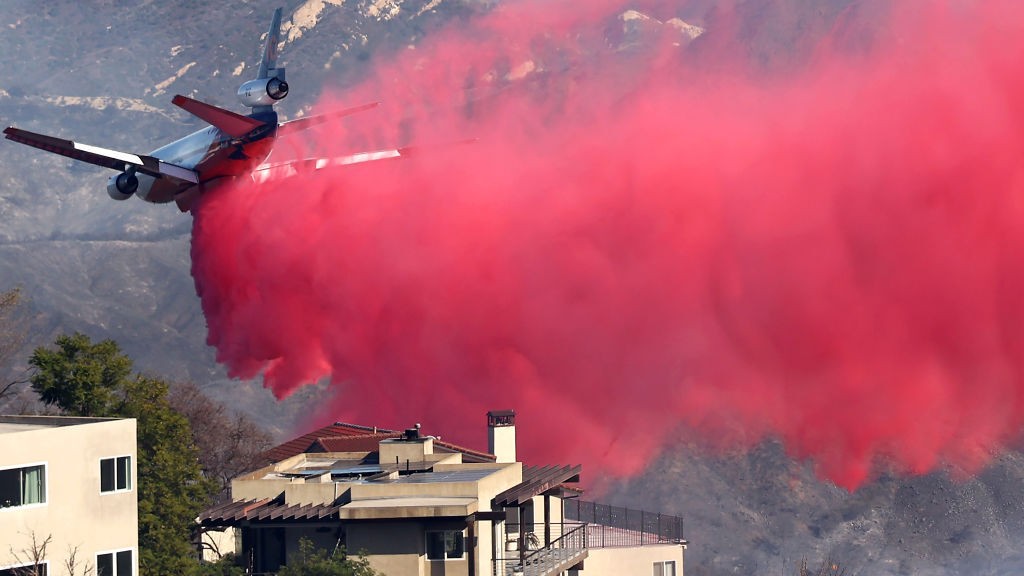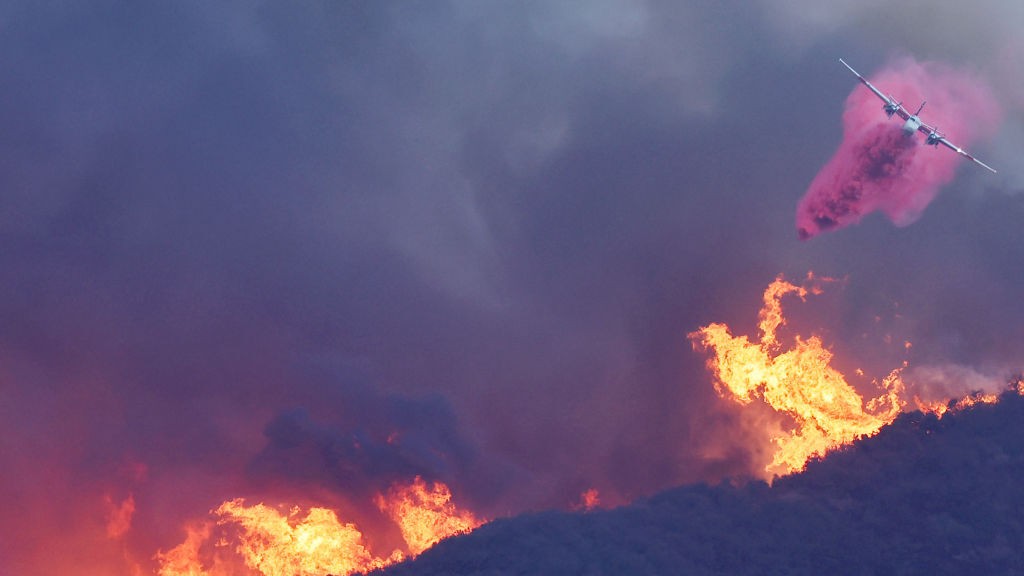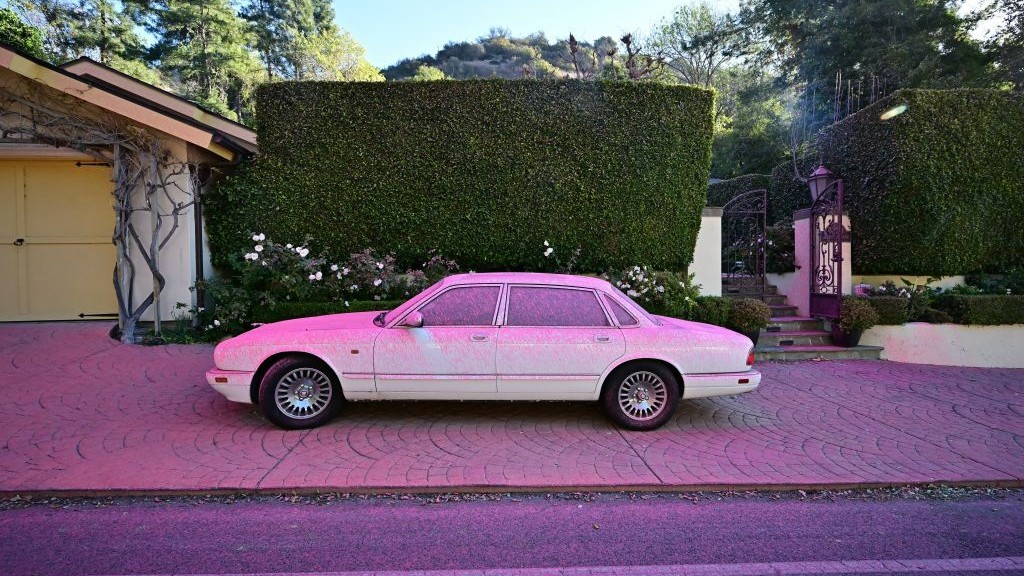
Pink fire retardant is raining from the skies in Los Angeles as firefighters try everything they can to contain several deadly wildfires.
Air tankers have dropped thousands of gallons of pink — or reddish — fire retardant to slow the spread of wildfires, which have killed at least 24 people at the time of this reporting. The firefighting strategy has turned homes, cars, streets, trees, and pretty much everything else pink in some areas, which begs the question, what is this pink fire retardant?
The pink fire retardant is made up of water mixed with a brand of powder concentrate called Phos-Chek, which is manufactured by a company called Perimeter Solutions. The company has made several different versions of Phos-Chek, but the U.S. Forest Service currently uses Phos-Chek MVP-Fx.
How does the pink fire retardant work?
Fire retardants help suppress wildfires by slowing the rate at which flames can spread. First, the flame retardant powder is mixed with water to create a foam or slurry that is easy to spread across affected areas.
The aerial retardant cools and coats anything flammable in the environment, including grasses, shrubs and trees, which otherwise become fuel for the fire. This process depletes the fire of oxygen and slows the rate of combustion because inorganic salts within the retardant change how the fuels burn, according to Forest service guidelines.
Plant cell walls are made up of cellulose, which normally decomposes when heated to produce more fuel for the fire. However, Perimeter Solutions says that its retardant alters the decomposition of cellulose and creates a non-flammable carbon, which doesn't fuel flames.
"This deprives the fire of fuel, reducing fire intensity and rate of spread," Perimeter Solutions states on the MVP-Fx product data sheet.
Related: Stark 'drought' maps reveal just why wildfires have blazed through Los Angeles
The bright pink color allows pilots and firefighters to see the retardant from the ground and from the air. This color then slowly fades when exposed to sunlight, according to Perimeter Solutions.

It's hard to measure the efficiency of fire retardant because it's one of several tactics used to fight wildfires, The New York Times reported. Other firefighting tactics include creating breaks in vegetation and spraying water, both on the ground and from the air.
The problem with just using water to fight an intense wildfire is that it evaporates. Fire retardants, on the other hand, contain fertilizer and other ingredients that don't evaporate once the water they're mixed with is gone, delaying a fire's spread for days, weeks or longer. By slowing down wildfires, the fire retardants give firefighters time to work on the ground, according to the Western Fire Chiefs Association.
Does pink fire retardant harm the environment?
There are some environmental concerns surrounding the use of fire retardants. A 2024 study published in the journal Environmental Science and Technology Letters found that long-term fire retardants contained toxic metals, including lead, arsenic and thallium. The researchers, from the University of Southern California, estimated that fire retardants added more than 400 tons (380,000 kilograms) of toxic metals to the environment between 2009 and 2021.
The study included Phos-Chek LC95W, which is an older Phos-Chek product recently phased out by the Forest Service. A representative of the Forest Service told NPR that for 2025, it phased out the LC95 product nationwide in favor of the newer MVP-Fx — having already switched to MVP-Fx in California — and said that data shows MVP-Fx is less toxic to aquatic life.
A spokesperson for Perimeter Solutions told The New York Times that retardants used for aerial firefighting had passed "extensive testing to confirm they meet strict standards for aquatic and mammalian safety."
However, Perimeter Solutions states on the MVP-Fx safety data sheet that the product "may cause long-term adverse effects in the aquatic environment."
Aerial retardant drops are prohibited in certain areas, including waterways and habitats in which endangered species live. However, there is an exception "when human life or public safety are threatened and retardant use in the aerial retardant avoidance area could be reasonably expected to alleviate the fire threat," according to Forest service guidelines.

What's in pink fire retardant?
The fire retardants are mostly ammonium phosphate fertilizer and a few other ingredients mixed with water. Perimeter Solutions doesn't publicly list all of the ingredients of MVP-Fx powder, which it describes as "trade secrets"— anyone could copy the product if they did. However, the main ingredient is monoammonium phosphate — commonly used as a fertilizer — which makes up 80% to 90% of the mixture. The product also contains diammonium phosphate and performance additives, according to the MVP-Fx safety data sheet.
Is pink fire retardant safe for humans?
Phos-Chek MVP-Fx doesn't contain any substances known to the state of California to cause cancer, developmental or reproductive harm, according to the MVP-Fx safety data sheet.
The MVP-Fx product comes with some warnings, such as avoiding unnecessary contact with it and removing it from eyes, skin, and clothing. Perimeter Solutions described MVP-Fx as "minimally irritating to the eyes" and "non-irritating to skin" in the MVP-Fx product data sheet. However, inhaling it may cause irritation to the respiratory tract.
Compared to the wildfires themselves, the warnings on Phos-Chek MVP-F are tame. Wildfires not only burn people but also produce toxic smoke that can linger for weeks to months.
Daniel McCurry, an associate professor of civil and environmental engineering at the University of Southern California who was part of the research team that found metals in fire retardants, told NPR that people in a fire zone likely have more pressing worries than the Phos-Chek.
"In terms of immediate concern, the main thing I'd be worried about, regardless of whether there's fire retardant used or not, is just air pollution — like particulate matter," McCurry said. "If you're walking around in an area that's been burned, it's probably still very smoky. So it'd be a good idea to wear a respirator."







